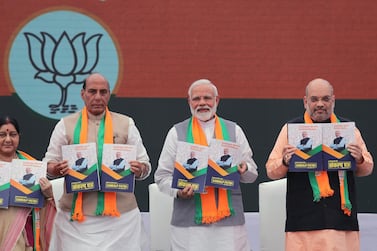In the biggest democratic exercise in human history, nearly 900 million people will start heading to the polls on Thursday as India’s multi-stage election begins.
Although voters only cast a ballot for members of parliament from their own constituencies, the perception among many is that this election is a referendum on Prime Minister Narendra Modi.
The prime minister has led his Bharatiya Janata Party (BJP) to a romping majority in the last election in 2014 and is now attempting to convince voters that his government’s economic record is less dismal than its critics claim. He is arguing that he is the best choice to keep India safe from corruption and insecurity.
The various parties arrayed against the BJP, however, point to the rising rate of joblessness, the Hindu nationalism that imperils minorities and the government’s illiberal tendencies. “The BJP has divided India in the last five years,” Rahul Gandhi, the president of the main opposition Congress party, said last week in reference to Hindu right-wing attacks upon Muslims, Christians and members of the lower castes.
As ever with Indian elections, the 2019 contest features many moving parts. There are interlocking combinations of candidacies, local electoral affinities, state-level powerhouses, and potential national-level coalitions.
Mr Modi’s BJP is expected to win a thin majority, the average of four polls ahead of voting indicated. The poll average shows the BJP winning 273 of the 543 seats in parliament giving a majority of one seat. In the last election the alliance won more than 330 seats – the biggest mandate in three decades. Coalition governments are not uncommon in India.
The BJP
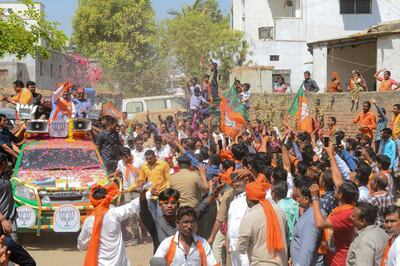
The BJP’s star campaigner has been Mr Modi himself. He has decided to seek re-election from Varanasi, the ancient seat of Hindu spirituality in Uttar Pradesh. In 2014, Mr Modi was challenged in Varanasi by Arvind Kejriwal, the leader of the Aam Aadmi Party (the Common Man’s Party). Mr Modi won by more than 330,000 votes.
Mr Modi’s promises for the city remain unfulfilled. He had vowed to turn Varanasi into a facsimile of the Japanese city of Kyoto – to improve the embankments along the Ganges River and to clean the river itself. None of this has happened.
But except for 2004, a candidate from the BJP candidates has won Varanasi at every election for a quarter-century, and Mr Modi is likely to win handsomely once more.
The prime minister’s real challenge lies in addressing other parts of the country, and in “getting voters to overlook the state of the economy and give it another five years to tackle bread-and-butter issues that Indians care about like jobs, agricultural prices, and livelihoods,” said Milan Vaishnav, the director of the South Asia program at the Carnegie Endowment for International Peace in Washington DC.
India’s unemployment rate, according to leaked government data, is around 6 per cent, the highest in four decades. Mr Modi’s failed attempt in 2016 to tackle corruption by demonetizing high-denomination notes and his bungled roll-out of a unified sales tax system have both hit the economy.
Last year, according to data from the Mumbai-based think tank Centre for Monitoring Indian Economy, the country actually lost 11 million jobs, even as close to a million people entered the workforce each month.
The Congress
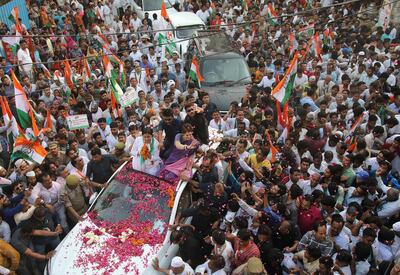
In 2014, after running the government for two successive terms, the Congress won a mere 44 seats in the 543-seat Lok Sabha, the lower house of parliament. It was the lowest-ever tally for India’s grand old party, hit as it was by numerous corruption scandals.
Subsequent state elections showed that the party had lost the trust of the electorate comprehensively. Only in the odd state contest, such as in Karnataka, was the Congress able to triumph over the BJP.
The party released a progressive manifesto last week, but its electoral muscle has yet to recover. Its best bet to oust the BJP, Mr Vaishnav said, is to play kingmaker, gathering together parties in a post-election coalition to form the government.
Other analysts agreed. “The Congress will need to aggressively lead the attack against the policies of the BJP without making it a leadership fight,” Sandeep Shastri, a political scientist at Jain University, said. “The Congress will be crucial to a coalition though its leadership will not be central to it.”
Mr Gandhi has been vocal in his criticisms of Mr Modi, but unusually, he has chosen to contest from Wayanad, in the southern state of Kerala, in addition to the family stronghold of Amethi in Uttar Pradesh.
He has won in Amethi since 2004, Mr Vaishnav pointed out, but the BJP was fielding one of its ministers, a former soap opera star named Smriti Irani, to run against him. She has “been carefully cultivating the constituency for the last five years,” Mr Vaishnav said.
“The second, and not mutually exclusive, possibility is that Gandhi seeks to energize the Congress organization in the South, where it has fallen on hard times in recent national elections,” he added. “By contesting from Wayanad, Gandhi hopes to send the message that the Congress is the only national party that has a real foothold in the South, where the BJP has historically been a bit player.”
As the hopeful prime ministerial nominee of the Congress, Mr Gandhi has had to build his image painstakingly.
“He has become more consistent, diligent and effective, [but] he is still no match for Modi as far as his popularity or charisma are concerned,” Mr Vaishnav said. “When it comes to ideas, the Congress has relied far too heavily on articulating what the BJP has done wrong, as opposed to what it would do if it were given a shot at power.”
The 'mega-coalition'
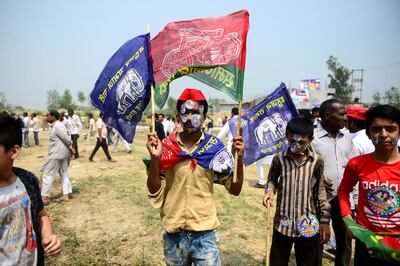
In the northern state of Uttar Pradesh, home to the largest number of constituencies sending 80 MPs to fill the Lok Sabhas 543 seats, a marriage of convenience has taken place. The two strongest regional parties, the Samajwadi Party (SP) and the Bahujan Samaj Party (BSP), have put past tensions behind them and partnered in an explicit bid to defeat the BJP.
During the last election, the BJP won 71 out of the 80 seats in the state—a feat pulled off by Mr Modi’s chief strategist, Amit Shah. Three years later, when the same parties fought it out in a state election, the BJP won 325 out of 403 legislative assembly seats. It seemed as if the BJP had put one of India’s most crucial battleground states firmly in its pocket.
But the electoral arithmetic of caste and religions affinities are complex in Uttar Pradesh, and the SP and the BSP figure that by consolidating their bases, they can beat back the BJP’s candidates. The alliance, Mr Vaishnav said, hopes to bring down the BJP’s tally of seats by at least half.
The SP and BSP are part of a larger nationwide coalition of 15 parties, called the Federal Front. They differ on ideologies, being united purely in their desire to unseat Mr Modi and the BJP. It is unlikely that the Federal Front “will automatically and smoothly turn into a ruling coalition should the BJP fail to form the government,” said Nitin Pai, director of the Takshashila Institution, a Bengaluru-based think-tank.
The lack of a coherent shared agenda and the inevitable struggles for power and influence in the event of they come out top might doom the Federal Front altogether. “If the opposition emerges victorious, expect the contradictions to begin surfacing right away,” Mr Vaishnav said. “Perhaps the most apt analogy is the period between 1996 and 1998 when India was ruled by a series of rickety coalitions and no fewer than four prime ministers.”
The Aam Aadmi Party
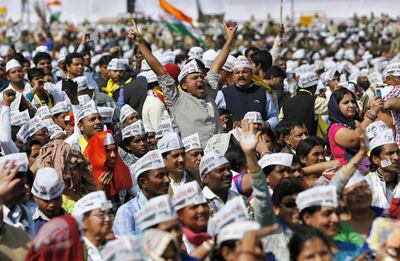
In 2014, the Aam Aadmi Party (AAP) was an upstart band of activists and outsiders who had formed less than two years earlier and ran on a platform of honest governance. They fielded candidates nationwide but with support mostly in urban areas they had little hope of taking seats outside major cities such as Delhi.
But of the seven parliamentary seats in the capital in 2014, the BJP won them all.
Then the following year, when Delhi held elections for its legislative assembly, the AAP won 67 out of 70 seats and installed Mr Kejriwal, a former tax officer, as chief minister. His tenure thus far has elicited praise for improvements in schools and neighbourhood clinics.
Mr Kejriwal himself will not contest any seats in the parliamentary election, but the AAP has allied with the Congress in an attempt to defeat the BJP – yet another marriage driven by the arithmetic of voter bases.
The alliance is, in itself, a sign of how the AAP has scaled back its ambitions, Mr Vaishnav pointed out. In 2014, Mr Kejriwal loudly portrayed his party as a national-level alternative to the BJP and the Congress, even though he had launched the party only a year and a half earlier. He was adamantly opposed to electoral partnerships, especially against the then incumbent Congress, whose governance and accused corruption had prompted him to found AAP in the first place.
This time around, Mr Vaishnav said, the AAP has more manageable goals: to elect its candidates running in its home base of Delhi; to maintain its presence in Punjab, where it won four Lok Sabha seats in 2014; and to expand its reach in the state of Haryana, adjoining Delhi. “In 2019, it has decidedly modest, regional ambitions,” Mr Vaishnav said.
